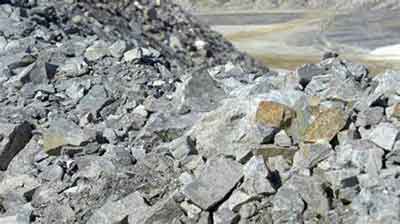Date: 15/02/2023
Relevance: GS-3: Science and Technology- developments and their applications and effects in everyday life.
Key Phrases: G3 category, inferred resources, Lithium-7, lithium-6, white gold’, Joshimath subsidence, Fragile and eco-sensitive region, big bang, moderate confidence estimates (G1+G2).
Context:
- The government, recently said that it has found 5.9 million tonnes of lithium reserves in Reasi district of Jammu & Kashmir.
Key Highlights:
- The discovery of lithium in Jammu & Kashmir is a major boost for India’s electrification plans but mining is a high-risk, high-reward game in the ecologically sensitive Himalayas.
- This may be the seventh largest deposit of the rare element, accounting for roughly 5.7% of all the reserves in the world.
- They are also said to be of a higher grade—550 parts per million (ppm) against the average 220 ppm—making it highly lucrative, given how lithium prices have soared in the last few years.
- According to the International Energy Agency, lithium prices went up more than seven-fold between the start of 2021 and May 2022.
- As the EV industry cheers on the recent discovery, a crucial aspect to look at would be the G3 category of lithium deposits.
What is the G3 category?
- According to the United Nations Framework Classification for Fossil Fuels, a G3 category or inferred resources is defined as quantities associated with a known deposit that can be estimated with a low level of confidence.
- Inferred resources mean that part of a mineral resource for which quantity and grade or quantity can be estimated on the basis of geological evidence and limited sampling and reasonably assumed, but not verified, geological and grade continuity.
- "A low estimate scenario is directly equivalent to a high confidence estimate (i.e. G1), whereas the best estimate scenario is equivalent to the combination of the high confidence and moderate confidence estimates (G1+G2).
- A high estimate scenario is equivalent to the combination of high, moderate and low confidence estimates (G1+G2+G3).
- Quantities may be estimated using deterministic or probabilistic methods.
About Lithium Metal:
- Lithium is the third element in the periodic table, with three protons and the element symbol Li. It has an atomic mass of 6.941.
- Natural lithium is a mixture of two stable isotopes, lithium-6 and lithium-7.
- Lithium-7 accounts for over 92% of the natural abundance of the element.
- Lithium is the lightest metal. Lithium has the lowest density of any metal.
- Because it reacts with air and water, the metal is stored under oil or enclosed in an inert atmosphere. When lithium catches fire, the reaction with oxygen makes it difficult to extinguish the flames.
- Lithium burns with a bright red color.
- It was one of three elements produced by the big bang, along with hydrogen and helium.
- The natural abundance of the element in the Earth's crust is about 0.0007%.
Significance of Lithium for India:
- Lithium is a soft, shiny grey metal found in the earth’s crust. Due to its ability to pack energy, it has utility across a range of sectors and has gained the moniker ‘white gold’.
- It is now primarily used to build the batteries that power modern appliances.
- They also power electric vehicles, a segment that will corner most of the global Lithium production in future.
- Currently, India does not have its own Lithium resources and like crude oil, it is dependent on imports.
- In fiscal 2022, India imported Lithium and Lithium ion worth almost ₹14,000 crore.
- These reserves are rare.
- By exploiting the potential of the lithium reserves in J&K, India could reduce its dependence on foreign countries making us truly ‘Atmanirbhar’, while also creating jobs, generating revenue, and furthering its renewable energy ambitions.
- India’s plan to increase EV penetration by 30% by 2030 relies heavily on Lithium.
What are the pitfalls of Lithium mining?
- Environmental Pollution: Just like any mining activity, there are adverse impacts on the environment, including water, soil and air pollution.
- Highly water-intensive: Extracting Lithium from its ore is highly water-intensive, taking about 2.2 million litres of water for one tonne of Lithium.
- Fragile and eco-sensitive region: The Himalayas are a highly fragile and eco-sensitive region and as the recent Joshimath subsidence shows, it is vulnerable to long-term adverse consequences of unplanned development works.
- Opposition from environmentalists: Mining in the region can attract opposition from environmentalists.
China’s Lithium Dominance:
- China does not have too much lithium reserve of its own, but as the largest market for electric vehicles, it controls both the supply and demand side of the lithium industry.
- It controls over half the global lithium processing and almost 75% of cell components and battery cell production in the world.
- In effect, the proliferation of EVs could mean India becoming dependent on China, just like it is reliant on the Middle East for crude oil today.
- J&K’s reserves, however, provide a major opening for India to be self-reliant.
Do you Know?
- According to a report by the International Energy Agency, China currently accounts for 58% of lithium processing globally, followed by Chile which accounts for 29% of lithium processing, followed by Argentina with accounts for 10%.
- In 2020-21, India imported an estimated ₹8,800 crore worth of lithium batteries 2020-21 and over ₹170 crore worth of lithium metal.
- Chile has the largest Lithium reserves in the world.
Conclusion:
- There is still some way to go before miners can extract lithium for industrial use.
- The discovery is ‘inferred’ or preliminary, the lowest of the three levels of estimations of a mineral deposit and the second of the four stages of exploration, as per the UN Framework Classification of mineral resources.
- There is much analysis to be done before its true value is confirmed.
Source: Live-Mint
Mains Question:
Q. Why is Lithium metal so important for India? What are the pitfalls of lithium mining? (250 Words).























